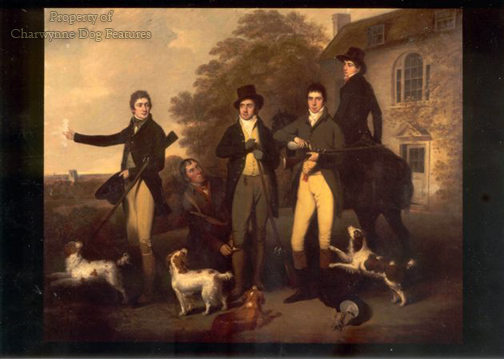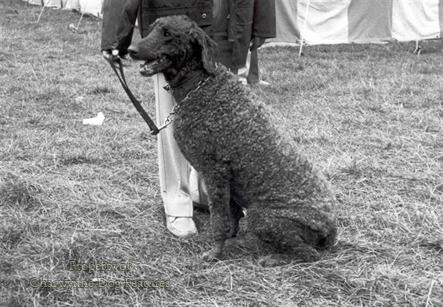376 USING ALL BREEDS OF GUNDOG
ASPIRING GUNDOGS
by David Hancock
"Went to shoot with Mr. Wakeford...and killed 3 hares, 2 pheasants, and 1 partridge. We shot with spaniels, and soon after we began were joined by a sheepdog, who forsook his flock to spend the day with us, and rendered us more service than any one of the cry; he kept well in bounds while we were beating; ran the pheasants off their legs the moment we found them, and pressed the hares so hard that he obliged most of them to leave the hedgerows within shot". This excerpt from Colonel Hawker's classic diary, for October the 26th, 1810, is enough to make any spaniel-fancier splutter into his soup. But a comparable quote from General Hutchinson's greatly-revered work, "Dog Breaking" of 1909, doesn't do much for the morale of pointer enthusiasts either: "...a gentleman then living on the Mall at Birr, made a bet of a pony...that his terrier bitch would point all the kinds of game found in the neighbouring bog; and further, that before it was sprung he would name what description of game the dog was pointing. The gentleman won his bet handsomely, though they found snipe, woodcock, grouse, hare, and...a duck." What have our professional pointer trainers been doing these last 80 years?
Many of us, too, know of similarly eccentric canine behaviour. I know of a bullmastiff, a German shepherd dog, a saluki, an Ibizan hound and a Rhodesian ridgeback regularly picking up. I read a decade ago of Brian Taylor in Norfolk who had trained his Rottweiler as a gundog, giving a whole new meaning to the expression "all-rounders from the continent"! Are we taking our accepted gundog breeds too seriously or our non-gundog breeds not seriously enough? Do we really need another 36,000 Labradors and 12,000 English springers each year!
A specialist breed should normally excel within the limitations of its allotted role and we have plenty of top-class gundogs who could run rings round the ambitious "amateurs". But how weary I have become of those who can only see merit in Labradors and English springers, two breeds I admire. I do get so tired of hearing and reading that all curly-coated retrievers are hard-mouthed and too "slow to mature", that Clumbers are finished, field spaniels no good any more, Chesapeake Bay retrievers hard to train and Sussex spaniels only fit for the show-ring. We all have our preferences and a perfect right to express our opinions too. But far too many gundog writers over the last quarter of a century have elected to see only good in English springers and Labradors, and there is plenty that is good in these two excellent breeds, and only faults in our other gundog breeds. If there are faults of course in any breed they should be acknowledged and then countered rather than regarded as ineradicable. Such "writing-off" by the opinionated has, in no small way, assisted the decline in numbers and field use of the minor gundog breeds in Britain.
We now only have around 150 Clumber, 100 Sussex, 100 Field and 140 Irish water spaniels, 140 curly-coated and 150 Chesapeake Bay retrievers registered each year with the Kennel Club. Against this decline, the resultant increase in the numbers of Labrador and golden retrievers and English springers has led to overbreeding from indifferent stock, an increase in the incidence of inherited diseases, a distinct loss of 'type' and a deterioration in temperament. If we halved the numbers of the most popular gundog breeds we would still have 17,000 Labradors, 6,000 golden retrievers and 6,000 English springers. Every gundog breed needs a balance between quantity and quality.
Nowadays, I despair of seeing a truly ”golden• retriever and with the loss of the authentic yellow in yellow Labradors too, perhaps we should now be advertising, in the wake of the Trades Descriptions Act, "cream-coloured retrievers" rather than the two original breeds involved. All too often I see working springers which but for their colour would pass as cocker spaniels. I find far too few Labradors with the gentle eye and classic head of the traditional breed. The Rottweiler head now seems to be a Labrador feature too. But even more worrying is the incidence of inherited diseases in the more numerous gundog breeds.
Progressive retinal atrophy has already been found in cocker and English springer spaniels, Labradors and golden retrievers and hereditary cataract in the latter two breeds; retinal dysplasia occurs in Labradors and English springers, hip dysplasia in Labradors, English springers and golden retrievers and congenital kidney disease and distiachiasis in cockers. Now osteochondritis dissecans and Von Willebrands' disease occurs in golden retrievers, anury and cranioschisis in cockers and elbow dysplasia, haemophilia A and "floppy syndrome" in Labradors.
But even more worrying comes the rising concern over problems of temperament in our popular gundog breeds. Sudden inexplicable violent behaviour in golden cocker spaniels (known as the rage syndrome) has been experienced for some years. More recently animal behaviourists have placed Labradors, cocker spaniels and even golden retrievers high on the list of over-aggressive dogs. The common factor in all these physical and mental abnormalities in these breeds is the very large numbers being bred, sadly all too often by less than well-informed breeders.
Labradors, golden retrievers and English springers became widely used in the shooting field partly on sheer merit but mainly because they were promoted by wealthy often aristocratic patrons. This is of course quite admirable in its way until such time as members of the middle classes and not always sportsmen themselves, copy this style and acquire the sporting dogs favoured by their peers to demonstrate a superior lifestyle.
The breed population explosion which ensues plays into the hands of unworthy breeders, field capability is either relegated or even undesired with unsound dogs emerging from puppy-farms to satisfy demand. Of course, real shooting men in traditional areas retain good bloodstock but you only have to go to a working test to see wild unstable examples of these breeds or to a conformation dog show to see handsome but physically handicapped specimens.
I believe the time is now right for the lesser known and under-rated breeds of gundog to be championed by enterprising sportsmen and bred up to the level achieved by such gifted breeders as made the Labrador retriever the sporting dog of the twentieth century. A wealthy patron or two would help no doubt but I am not confident that our contemporary aristocracy have the eye for a dog of their ancestors.
I have in mind retrievers like the curly-coat and Chesapeake Bay, spaniels like the field and a water-dog like the whiptail. These are unspoiled breeds with strong instinctive skills, much individual appeal and, when successful in the field, reflect that much more on their trainers and handlers simply because they are essentially different from the more popular better known gundog breeds. A thoroughly unspoilt gundog breed is the centuries-old curly-coated retriever, the biggest of the retriever breeds and the best as a watchdog, solid and dependable. And yes, this breed does grow up in its own time; does precociousness always turn out for the best? With their unique astrakhan coats, they are such distinctive dogs. I was simply delighted one day last year to see two fine-looking liver specimens come bounding out of a range-rover; I had thought only black Labradors came out of range-rovers!
The distinguished gundog writer James Wentworth Day, who didn't overpraise any dog, once wrote of one: "Then there was Bruno, the curly-coat...He was a good looker from nose to tail. He stood well and he moved well. He would face any tide and sniffed at the cold. I remember sitting for three and a half hours one winter afternoon in a sunken barrel by the side of the fleet on a marsh at Silcott, snow falling and a north-easterly half a gale blowing. Bruno scarcely moved the whole time and never whimpered".
Wentworth Day also wrote admiringly on another retriever: ..."If you have two or three Chesapeakes in the kennel there will never be any disturbances in your shooting routine--none of that hoity-toity flightiness of the Gordon setter, the kiss-me-quick slobberings of the spaniel or the mental whimperings of the golden retriever. Do not imagine for a moment that I dislike any of these three excellent breeds of sporting dogs. But I mourn for individuals among them. The show-bench and the drawing-room have made fools of them, undermined their character, ruined their stamina, set their nerves on edge...I doubt if you could ever do that with the Chesapeake. He will probably bite someone finally, just as a protest and then walk out of the house, a dog in search of a man for a master."
In an ideal world every gundog worth the name should have a sporting man for a master. But every sportsman in search of a gundog should not have to be wary of clicking hip-joints, ingrowing eye-lashes, slipping knee-caps, approaching blindness or hyper-aggression in his future purchase. But since it is perfectly legal to breed from dogs possessing hereditary diseases and even working lines containing bad genes, it has become a lottery in the dog-purchasing game, with few safeguards for the innocent buyer. The lesser-known gundog breeds may now have a wider role to play...but God help them if they ever become popular!